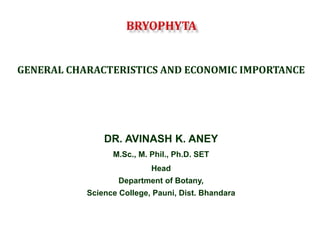
Bryophyta General Characteristics and Economic Importance - Copy.ppt
- 1. GENERAL CHARACTERISTICS AND ECONOMIC IMPORTANCE DR. AVINASH K. ANEY M.Sc., M. Phil., Ph.D. SET Head Department of Botany, Science College, Pauni, Dist. Bhandara
- 2. GENERAL CHARACTERISTICS Occupy position between aquatic algae and land inhabiting pteridophytes Called amphibians of plant Kingdome Plant body independent gametophyte Habitat: Found in damp, humid, and shaded regions. Some found in aquatic conditions too: Riccia flutians, Ricciocarpous, Fontinalis. Nutrition: They are mainly autotrophic. Certain species can be saprophytes, such as Buxbamia, Cryptothallmus Plant Body: Plant body is haploid independent gametophyte may be dorsiventrally differentiated (Thalloid) or differentiated into stem and leaves (Foliage) In foliage: Leaves arranged in 2 or 3 rows on the axis and always without midrib Sporophyte is diploid and dependent on gametophyte Gametophyte produces haploid gametes (n) Sporophytes are diploid and produces haploid spores by meiosis
- 3. True roots absent. Unicellular or multicellular hair-like rhizoids present ventrally Rhizoids absorbs water and nutrients from soil and are of two types: Smooth walled Tuberculate Vascular tissue i.e. xylem and phloem absent All bryophytes are homosporous Spores germinate into filamentous or thalloid protonema
- 4. Internal structure simple consisting of parenchymatous tissue with chloroplast Differentiated into upper chlorophyllous tissue and lower storage region Presence of large or small air chambers with branched or unbranched filaments Each air chamber opens outside by an opening called ostiole
- 5. Reproduction: Reproduces by following methods Vegetative Reproduction: Takes by following ways 1. By death and decay of older parts of the thallus: (Riccia, Marchantia, Notothylas) 2. Fragmentation: (Riccia, Marchantia, Anthoceros) 3. Adventitious branches: (Marchantia, Funaria) 4. Tubers: (Marchantia, Linularia) Asexual Reproduction: Takes place by 1. Gemmae: Special structure developed in gemma cups (Marchantia) 2. Spores: Haploid spores produced in sporogonium
- 6. Sexual Reproduction: Oogamous (takes place inside female sex organs) Takes place by the formation of gametes in sex organs Jacketed sex organs produced on gametophyte Antheridium: Male sex organ, Archegonium: Female sex organ Antheridium: Globose, Club shaped, oval or elongated stalked structure Covered by single or multilayer jacket of sterile cells Accommodates the sperm mother cells (androcytes or spermatocytes) Androcytes metamorphoses into biflagellated antherozoid or spermatozoid (n) Archegonium: Flask-shaped, stalked structure covered by single or two layered sterile jacket Differentiated into upper elongated, narrow neck and lower swollen venter Neck consist of axial row of cells called neck canal cells (NCC) Venter contains upper sterile venter canal cell (VCC) and lower fertile egg cell (n) Tip of Archegonium covered by four lid or cap cells
- 8. Fertilization: Oogamous: Takes place within archegonial venter Water is very essential for the act of fertilization Antherozids (Male gametes): Biflagellated, chemotactic and motile Attracted towards the chemical secreted by archegonia Swim on the film of water and reaches archegonial neck All NCC and VCC disintegrates to form sticky mucilage containing malic acid Lid or cap cells separates to form minute opening for entry of spermatozoids Many sperms enter the Archegonium but only one unite with egg cell Union of sperm nucleus (n) with egg nucleus (n) forms diploid zygote Divides repeatedly to form multicellular embryo and into sporophyte
- 9. Sporophyte: May be simple (Riccia) or complex (Marchantia, Funaria, Anthoceros) Differentiated into foot, seta and capsule Venter layer develops into protective covering called calyptra Sporophyte may have columella (Anthoceros) or opercuum (Funaria)
- 10. Spores: Unicellular, uninucleate haploid (n) structure Covered by two wall layers: Exine or Exosporium: Outer, thick, sculptured and rough with germ pores Intine or Endosporium: Inner, thin, elastic and smooth Spores: Tiny and light by weight, easily carried by wind current Germinate on suitable substratum to produce young gametophyte (Protonema)
- 11. Alternation of generation: Heteromorphic and haplo-diploidy type Two important events maintain the chromosome number: Fertilization and meiosis Consist of two phases 1. Gametophytic phase: First, dominant, haploid and independent Gametophyte may be monoecious (Bisexual) or dioecious (Unisexual) Haploid gametes produced in separate sex organs (Antheridium and Archegonium) Starts with meiosis and ends in fertilization Fertilization results in formation of diploid zygote (2n) 2. Sporophytic phase: Second, conspicuous, diploid and dependent on gametophyte Starts with fertilization and ends in meiosis Meiosis results in production of haploid spores in capsule Two generations are morphologically different hence called heteromorphic Two phases comes in alternate manner with one another hence called alternation of generation.
- 12. Life cycle:
- 13. Economic importance of Bryophyta: Economically less important. Few bryophytes economically important Ecological importance: Few bryophytes help in establishing vegetation on barren lands Colonize the barren rocks and exposed areas of hills and make them suitable for growing other plants by decomposing soil and depositing humus in the soil Initially grasses grow and then shrubs and finally trees establishes Sphagnum plant: great ecological importance Grows faster and cover the whole surface of water. Surface raised above due to deposition of plant debris. Sphagnum along with other bryophytes forms dense covering over the water It gives appearance of the soil from the surface. Known as ‘quacking bags’. Later, it converts into swamps and finally replaced by the forest growth of mesophytic type Few bryophytes play important role in checking soil erosion. Packing material: Most of the bryophytes used as packing material after being dried Used for packing material for glassware and other fragile goods
- 14. Dried peat mass (Sphagnum sps.) used to pack buds, cuttings and seedling for shipments Used in seed beds: Peat mosses have remarkable power to absorb and hold water like sponge Extensively used in seed beds in nurseries and green houses As a source of fuel: Peat is also a potential source of coal. Used as fuel in Ireland, Scotland and other European countries Absorbent bandages: Sphagnum plants is slightly antiseptic Used as absorbent bandages in place of surgical cottons, in hospitals.